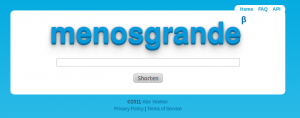menosgrande - My First Ruby on Rails App!
I’m proud to announce the release of my first Ruby on Rails app - menosgrande!
It’s not a very complicated application; it’s just a URL shortener. However, I’ve tried to make it the most efficient URL shortener in existence by doing a few things uniquely that I don’t see any other URL shorteners doing:
- Unicode paths (i.e. IRIs). While other URL shortening services use the digits [a-zA-Z0-9] only as keys, resulting in 62 unique characters, menosgrande uses over 107,000 unique Unicode code points. By using so many code points, menosgrande can store over twelve times the number of URLs in two Unicode digits than other services using five base-62 digits compare 107000^2 to 62^5 to see the difference).
- Short domains. Some services use long domain names, which waste characters from the start (e.g. goo.gl, tinyurl.com, etc.). menosgrande uses the shortest combination of characters possible: a two-digit TLD and a single-digit subdomain, resulting in a base URL that is already extremely short. Currently, the only way you can theoretically get a shorter DNS address than this is by doing insanity like using a root ccTLD like the .to ccTLD used to do (which it no longer does).
- Multiple domains. menosgrande doesn’t attempt to use a single unique domain name for short links. Instead, it keeps a pool of domains for that purpose. Each domain in this pool multiplies the number of URLs that menosgrande can shorten.
Caveat: the Unicode trick only works if the service reading the shortened URL counts Unicode code points as single characters, and not raw bytes. Obviously, this is exactly how Twitter counts characters, or I wouldn’t have done this. Just wanted to point that out before you make a fool out of yourself with a loud-mouthed, incorrect statement.
The hardest piece of the puzzle to solve was which Unicode code points to use as keys, because Unicode doesn’t simply encode simple alphabetical characters like the Latin alphabet. There are lots of formatting characters, whitespace characters, private use characters (for internal Unicode parser usage), control code characters (e.g. NUL), and lots of others that would not work for my URL shortener. Unicode is such a dry read, it took me a while to understand all of the code points that need to be filtered out. I eventually came up with a decent list:
- Noncharacters
- Control codes
- High/Low surrogates
- Private-Use
- Formatting, Bidirectional
- Combining characters / diacritical marks
- Whitespace
Then, it became quite a struggle to actually figure out how to apply this
filter to the full set of Unicode code points. I tried the Perl unichars utility,
which I believe has the capability to do what I need, but my version of Perl
(5.10.1) is linked to a Unicode 5.x standard; I couldn’t quickly find any
instructions for upgrading to the Unicode 6.0.0 standard. I had considered
writing a Ruby app similar to unichars, but my Ruby install is
also on a Unicode 5.2 standard (Ruby 1.9.2, ActiveSupport 3.0.8). I found
a way
to apparently load a different Unicode table, but there is no
documentation for it and the unicode_tables.dat file on my system is a binary
file so no easy answer there.
I had also considered parsing the Unicode 6.0.0 standard’s UnicodeData.txt file myself, but apparently there are ranges of code points missing, such as Han, which would require me parsing yet another file in its own format.
In the end, I stumbled across an official Unicode Properties JSP Web app that had the capability I needed, with full Unicode 6.0.0 support. Here is the filter that I used to select my code points:
[:Diacritic=No:]&[:Noncharacter_Code_Point=No:]&[:Deprecated=No:]&[:White_Space=No:]&[:General_Category=Math_Symbol:]|[:General_Category=Symbol:]|[:General_Category=Letter:]|[:General_Category=Punctuation:]|[:General_Category=Currency_Symbol:]|[:General_Category=Number:]&[:General_Category!=Modifier_Letter:]&[:General_Category!=Modifier_Symbol:]
which yielded 107,401 code points. I then had to filter out URI-scheme reserved characters
- and a few other characters that just make me paranoid - and I was still well over 107K code points. I then shuffled the order of the code points (seeding the PRNG with a constant value beforehand, to make the shuffle repeatable) and stored them in a Redis list, to keep them in main memory for fast access. I make use of a Ruby radix gem to convert my integer counter values into the Unicode code point values. So far, it appears to be working very well!
I know it isn’t the most complicated piece of software ever written, but it was a fun project and a good one for helping me learn Rails. I’m hoping it will also raise some basic awareness of Unicode in the process!
I’m not sure yet whether I’ll continue to work on features like an API, or just open source it and move on to another Rails project. Sometimes it’s hard to keep working on details once the interesting problem has been solved. I think it will depend on how soon I get a Rails job here in Madison.
Anyone want to hire me yet? :-)

